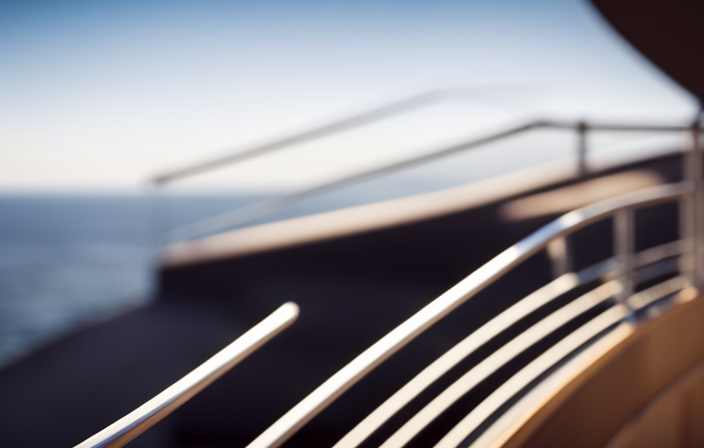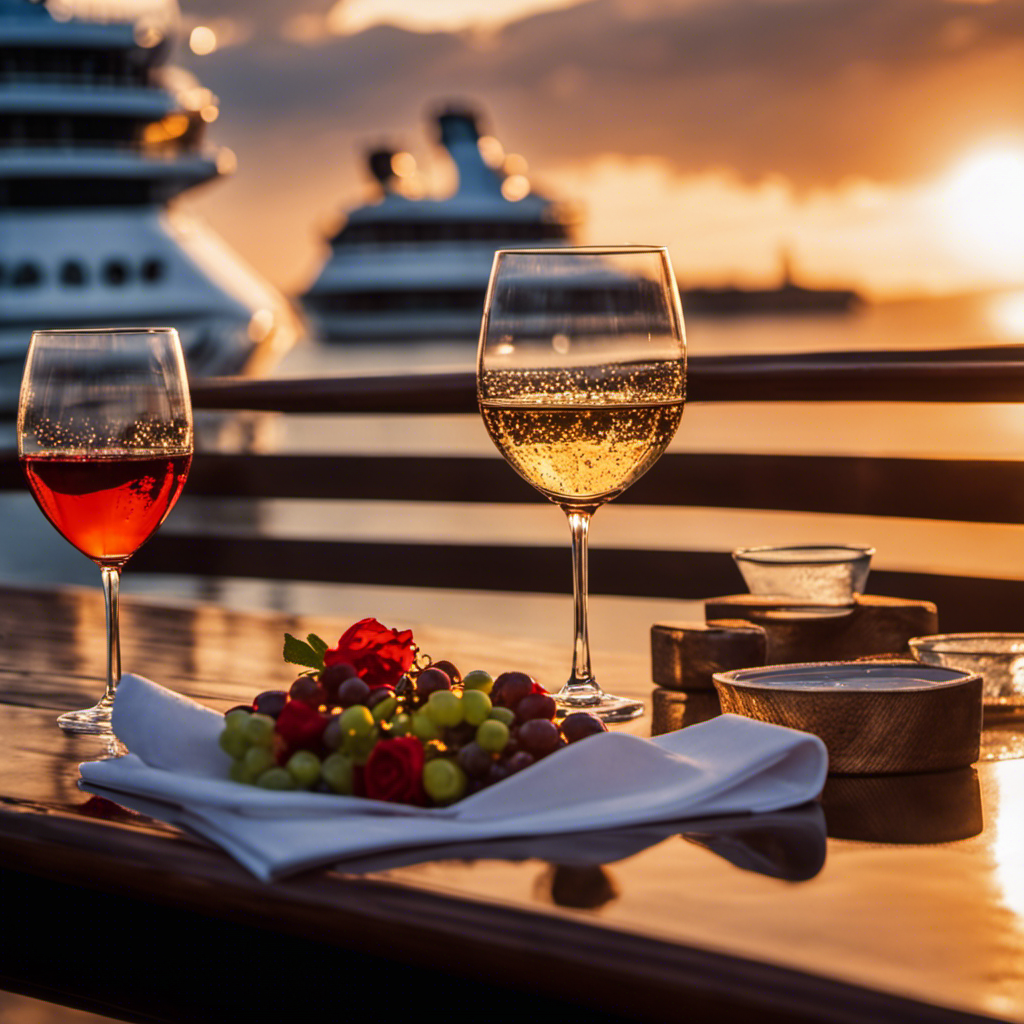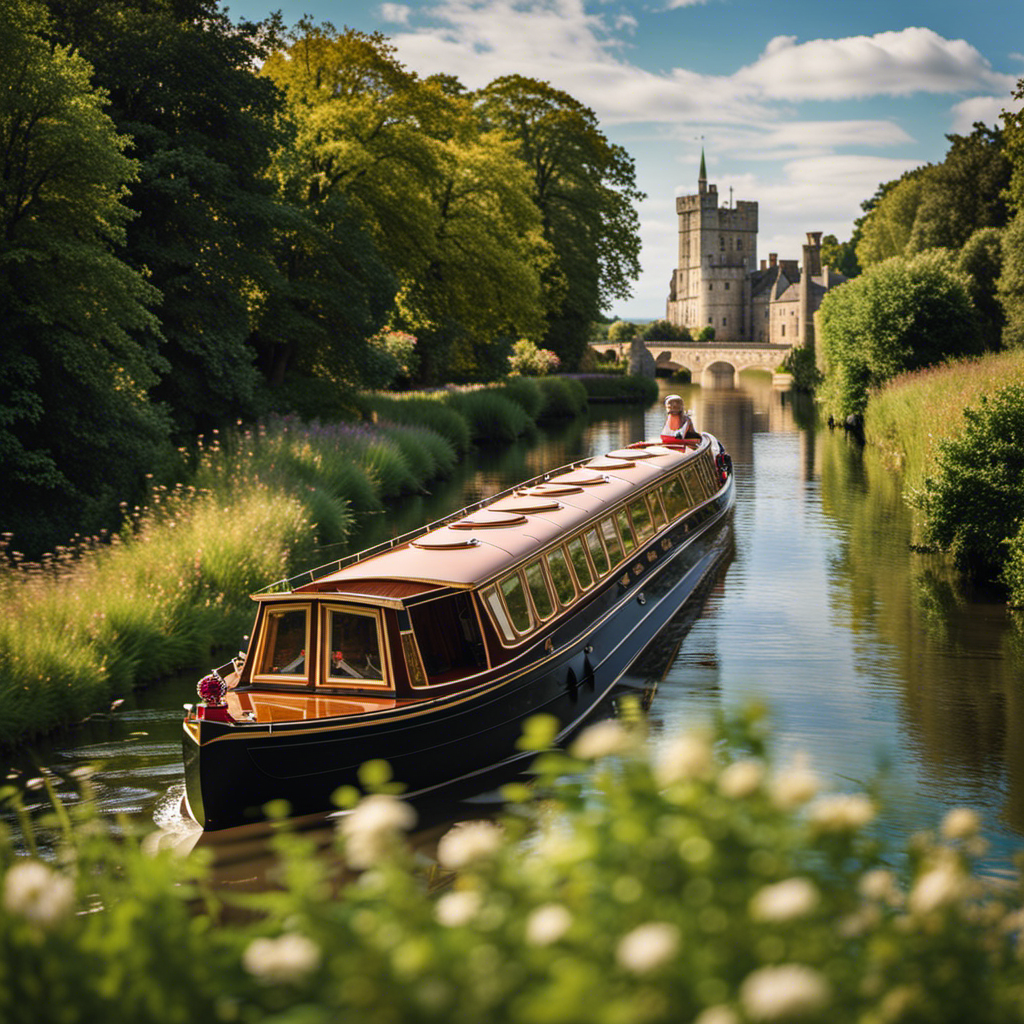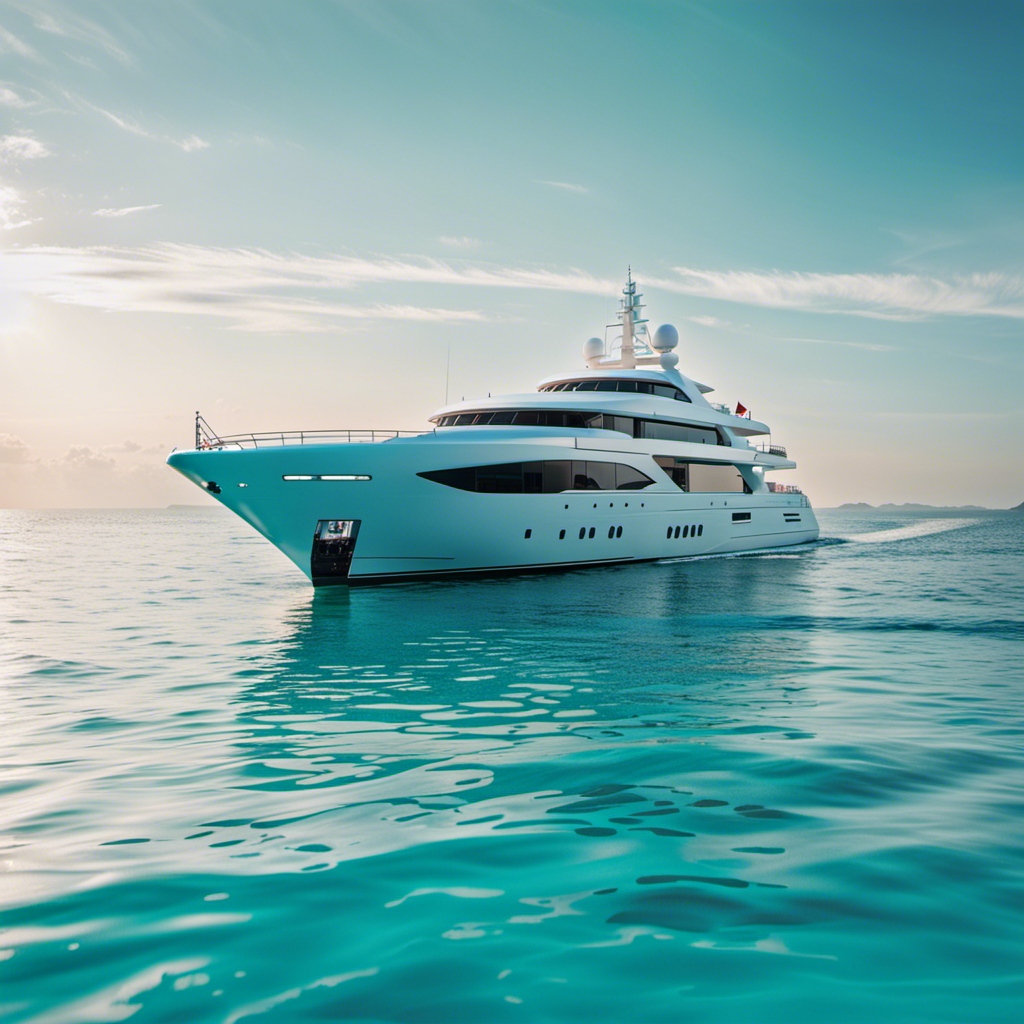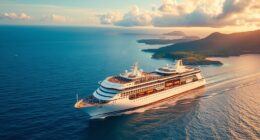Ever thought about how high **cruise ship** railings are? Discover the surprising height and importance of **cruise ship** railings to ensure a safe and enjoyable voyage. Learn more about this vital safety feature. Curious to find out?
Well, let me shed some light on this important aspect of passenger safety.
Cruise ship railings play a crucial role in preventing accidents and ensuring the well-being of passengers while they enjoy their time at sea.
In this article, we will explore the international regulations governing the height of these railings, as well as the average heights commonly found on cruise ships.
We will also delve into the design considerations and safety features that go into creating these essential barriers.
Additionally, we will discuss the potential risks and accidents associated with cruise ship railings, as well as the policies and guidelines established by cruise lines to promote passenger behavior and responsibility.
Stay tuned to learn more about the ongoing improvements and innovations in cruise ship railing safety.
Key Takeaways
- Accidents related to cruise ship railings account for a significant number of onboard incidents.
- Railing height is designed to prevent accidents and falls overboard.
- Higher railings provide extra protection, especially for children and those with limited mobility.
- Ongoing improvements prioritize passenger safety near railings.
Importance of Cruise Ship Railings for Passenger Safety
You may not realize it, but the importance of cruise ship railings for your safety cannot be overstated. These railings act as a safeguard, preventing passengers from accidentally falling overboard and ensuring a worry-free voyage.
International regulations for cruise ship railing heights have been put in place to ensure the safety of passengers. According to these regulations, the average height of cruise ship railings must be at least 42 inches. This height is carefully determined to prevent accidental falls while allowing passengers to enjoy unobstructed views of the surrounding ocean.
These regulations are strictly enforced, and cruise ships must adhere to them to maintain their certification.
Now, let’s delve into the details of the international regulations for cruise ship railing heights, ensuring your safety throughout your journey.
International Regulations for Cruise Ship Railing Heights
Regulations from various countries dictate the minimum height requirements for railings on these floating giants of the sea. International regulations play a crucial role in ensuring cruise ship safety. Here are four key points to consider:
-
SOLAS (Safety of Life at Sea): This international convention mandates a minimum railing height of 39.4 inches (1 meter) above the deck.
-
United States Coast Guard (USCG): The USCG requires railings to be at least 42 inches (1.07 meters) high on most areas of a cruise ship.
-
European Union (EU): European regulations specify a minimum railing height of 39.4 inches (1 meter) for most areas, but 47.2 inches (1.2 meters) for balconies.
-
Australian Maritime Safety Authority (AMSA): AMSA sets a minimum railing height of 39.4 inches (1 meter) above the deck.
These international regulations demonstrate the commitment to passenger safety on cruise ships. Now, let’s delve into the average height of cruise ship railings.
Average Height of Cruise Ship Railings
As you stroll along the expansive decks of a majestic cruise liner, the height of the protective barriers creates a sense of security and tranquility. Cruise ship railings are designed to ensure the safety of passengers and crew members, and their average height is regulated by international standards. These regulations aim to prevent falls overboard and maintain a safe environment onboard. The average height of cruise ship railings is typically around 42 inches, which provides a sufficient barrier to prevent accidental falls. To achieve this height, cruise ship railings are made from durable materials such as stainless steel or toughened glass. Regular maintenance and inspections are conducted to ensure the integrity of the railings, including checking for any signs of corrosion or damage. These measures guarantee that the railings remain sturdy and reliable throughout the lifespan of the vessel. Considering the importance of safety, cruise ship designers carefully consider various factors when designing railings, such as aesthetics, functionality, and compliance with regulations. This attention to detail ensures that passengers can enjoy their voyage without worry. Moving on to the next section, let’s explore the design considerations for cruise ship railings.
Design Considerations for Cruise Ship Railings
When it comes to designing cruise ship railings, there are two key considerations that must be balanced: safety and aesthetics. As a designer, I must ensure that the railings provide a secure barrier to prevent accidents and falls, while also integrating seamlessly into the overall design of the ship.
Additionally, the choice of materials used for the railings is crucial, as they must not only be durable and weather-resistant, but also visually appealing to enhance the overall aesthetic of the ship.
Balancing Safety and Aesthetics
Unfortunately, the cruise ship railings are designed to be just tall enough to give the illusion of safety, while still allowing for dramatic photo opportunities. Balancing aesthetics and passenger behavior is a delicate task for cruise ship designers. The railings need to provide a sense of security without obstructing the breathtaking views that passengers come to expect.
To achieve this, the height of the railings is carefully considered. They are designed to be tall enough to prevent accidental falls, but not so tall that they obstruct the view or create a feeling of confinement. The materials used for railings also play a crucial role in striking this balance. From glass to stainless steel, these materials are chosen for their durability, strength, and ability to blend seamlessly with the ship’s overall design.
Transitioning into the subsequent section about materials used for railings, it is important to explore the various options available.
Materials Used for Railings
When it comes to cruise ship railings, striking the right balance between safety and aesthetics is crucial. As mentioned earlier, cruise ship railings need to be sturdy and robust to ensure the safety of passengers. In order to achieve this, careful materials selection is of utmost importance.
The materials used for cruise ship railings are chosen based on their durability, strength, and resistance to corrosion. Common materials include stainless steel, aluminum, and glass. Once the materials have been selected, the railing installation process begins. This involves precise measurements, cutting and shaping of the materials, and meticulous welding or fastening techniques.
The goal is to create a secure and visually appealing barrier that enhances the overall look of the ship. With the materials in place and the installation process complete, the cruise ship railings are now ready to provide the necessary safety features for passengers.
Safety Features of Cruise Ship Railings
Cruise ship railings, designed to ensure passenger safety, are a crucial feature that protect against potential accidents. These railings not only serve a functional purpose, but also play a role in balancing aesthetics with safety.
They are typically made from sturdy materials such as stainless steel or tempered glass, ensuring durability and resistance to harsh weather conditions. In addition to their sturdy construction, cruise ship railings incorporate various safety features. These include a height requirement that prevents accidental falls overboard, as well as a design that minimizes the risk of climbing.
Moreover, the railings are regularly inspected and maintained by the crew to ensure their integrity. Crew members have the responsibility to monitor the condition of the railings and promptly address any issues that may compromise passenger safety.
With these safety measures in place, passengers can enjoy the stunning views and serene atmosphere on board cruise ships while feeling secure.
Role of Crew Members in Ensuring Railing Safety
To ensure the safety of everyone on board, you’ll be glad to know that crew members play a crucial role in regularly inspecting and maintaining the railings. They’re trained extensively in identifying any potential issues or weaknesses in the railings and take immediate action to address them.
Additionally, crew members are well-versed in emergency preparedness and are trained to respond quickly and effectively in case of any accidents or incidents involving the railings.
Crew Training:
- Rigorous training programs are in place to equip crew members with the necessary skills and knowledge to ensure the safety of passengers.
- Regular drills and simulations are conducted to ensure crew members are prepared for any potential railing-related emergencies.
Emergency Preparedness:
- Crew members are trained to respond swiftly to any accidents or incidents involving the railings.
- They’re well-versed in emergency protocols and are responsible for guiding passengers to safety during such situations.
With the crew’s expertise and dedication to safety, the risks and accidents related to cruise ship railings can be minimized.
Risks and Accidents Related to Cruise Ship Railings
Did you know that accidents related to railings on cruise ships account for a significant number of onboard incidents? It’s important for passengers to be aware of the risks associated with leaning on or climbing over the railings.
Cruise ship railings are designed to prevent falls, but they’re not foolproof. Leaning on the railings can lead to loss of balance and result in a fall overboard. In emergency situations, it’s crucial to follow the ship’s procedures and guidelines. Crew members are trained to respond quickly and efficiently to accidents involving railings, but prevention is always the best course of action.
Passengers should familiarize themselves with the emergency procedures and actively avoid risky behaviors near the railings. By understanding the potential dangers, we can ensure a safe and enjoyable cruise experience.
Now, let’s discuss cruise line policies and guidelines for passenger behavior.
Cruise Line Policies and Guidelines for Passenger Behavior
When it comes to cruise line policies and guidelines for passenger behavior, there are a few key points to keep in mind.
First and foremost, there are strict regulations in place regarding prohibited activities near railings. Passengers are advised to avoid leaning or climbing on railings to prevent accidents or falls.
Additionally, cruise lines have specific alcohol consumption regulations in order to ensure the safety and well-being of all passengers. It’s important to familiarize oneself with these guidelines to have a safe and enjoyable cruise experience.
Prohibited Activities near Railings
Please be cautious and avoid any prohibited activities near the cruise ship railings, as they’re designed to ensure your safety and enjoyment onboard. Cruise lines have strict guidelines in place to protect passengers from potential dangers.
Engaging in activities such as sitting, climbing, or leaning over the railings is strictly prohibited. These rules are enforced to prevent accidents and ensure the well-being of all passengers. Violating these railing rules can have serious consequences, including being removed from the ship or facing legal action. It’s important to respect these regulations and understand that they’re in place for your own safety.
By adhering to these guidelines, you can fully enjoy your cruise experience without putting yourself or others at risk.
Moving forward, let’s discuss the regulations regarding alcohol consumption onboard.
Alcohol Consumption Regulations
One important thing to note is that there are strict regulations in place for alcohol consumption onboard. Cruise ship railing maintenance is crucial to ensure the safety of passengers. The height of cruise ship railings is carefully designed to prevent accidents and falls overboard. Regular monitoring of alcohol consumption is essential to avoid any incidents near the railings. Cruise lines have policies in place to limit excessive drinking and ensure a safe environment for all passengers. Crew members are trained to recognize signs of intoxication and intervene if necessary. By closely monitoring alcohol consumption, cruise lines can help prevent accidents and maintain the safety of passengers.
In the next section, we will discuss passenger responsibility in staying safe near railings, emphasizing the importance of being cautious.
Passenger Responsibility in Staying Safe near Railings
Ensure your safety near cruise ship railings by staying alert and taking responsibility for your own well-being. As a passenger, it’s crucial to be aware of your surroundings and understand the potential risks associated with being near railings.
Familiarize yourself with the emergency procedures provided by the cruise ship, so you know what to do in case of an incident. Pay attention to any safety announcements or instructions given by the crew. Remember to never lean or climb on the railings, as they’re designed for your protection and not for recreational purposes.
By following these guidelines and being mindful of your actions, you can help create a safer environment for yourself and fellow passengers.
Now let’s explore the ongoing improvements and innovations in cruise ship railing safety.
Ongoing Improvements and Innovations in Cruise Ship Railing Safety
Stay on the cutting edge of safety as cruise ships continue to implement innovative measures that protect you from potential hazards near the edge of the oceanic oasis. Cruise ship companies are constantly working to improve railing designs and incorporate emerging technologies for railing safety.
One of the ongoing improvements is the installation of higher railings to provide an extra layer of protection. These taller railings ensure that passengers, especially children and those with limited mobility, are less likely to accidentally fall overboard.
Additionally, cruise ships are now utilizing advanced technologies such as motion sensors and surveillance cameras to detect any unusual movements near the railings. These technologies alert the crew immediately, allowing them to respond quickly and prevent any accidents.
By staying up-to-date with these ongoing improvements and innovations, cruise ship passengers can feel confident in their safety while enjoying the breathtaking views at sea.
Frequently Asked Questions
What are the specific measurements and dimensions of cruise ship railings?
Cruise ship railings have specific measurements and dimensions that ensure safety and compliance with regulations. These measurements vary depending on the ship, but typically range from 3 to 4 feet in height and are made of sturdy materials.
Are there any specific materials or construction techniques used to make cruise ship railings safer?
Cruise ship railings are crafted with meticulous care, using robust materials like stainless steel and tempered glass. They adhere to strict height regulations, ensuring the safety of passengers. It’s like constructing an impenetrable fortress that shields and protects.
Are there any particular areas of the ship where railings are taller or have additional safety features?
In certain areas of the ship, such as the open decks and higher levels, cruise ship railings are often taller and have additional safety features to ensure passenger safety and mitigate the impact of wind.
How often are cruise ship railings inspected and maintained to ensure their safety?
Cruise ship railings are inspected and maintained regularly to ensure passenger safety. Safety regulations dictate the frequency of maintenance, which includes checking for any structural issues and ensuring compliance with height and safety standards.
Are there any specific rules or regulations regarding passenger behavior near cruise ship railings, such as leaning or climbing on them?
There are specific rules and regulations regarding passenger behavior near cruise ship railings. Passengers are restricted from leaning or climbing on them to ensure their safety. These rules are enforced and followed to prevent accidents.
Conclusion
In conclusion, cruise ship railings are essential for passenger safety on board. They not only adhere to international regulations but also have an average height that ensures the well-being of passengers.
Design considerations and safety features further enhance the effectiveness of these railings. However, risks and accidents can still occur, highlighting the need for passengers to follow cruise line policies and guidelines.
As ongoing improvements and innovations continue, cruise ship railings will continue to provide a secure environment for passengers to enjoy their voyages.
Claire, a creative soul with an unquenchable thirst for storytelling, is an integral part of the Voyager Info team. As a dedicated writer, she weaves captivating narratives that transport readers to enchanting cruise destinations and beyond.
Claire’s love affair with writing began at an early age when she discovered the magic of words and their ability to craft worlds and emotions. Her innate curiosity led her to explore various literary genres, but it was travel writing that truly captured her heart. Drawing inspiration from her own globetrotting adventures and encounters with diverse cultures, Claire embarked on a journey to become a travel writer par excellence.

